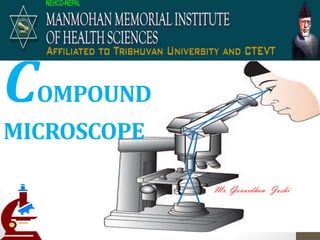
Compound microscope
- 2. Microscope • Microscope is the combination of two words; "micro" meaning small and "scope" meaning view. • Compound deals with the microscope having more than one lens.
- 4. History • Optical microscopes are the oldest and simplest of the microscopes. A 1879 Carl Zeiss Jena Optical microscope
- 5. The History • Hans and Zacharias Janssen of Holland in the 59 ’s reated the first o pou d i ros ope • Anthony van Leeuwenhoek and Robert Hooke made improvements by working on the lenses Anthony van Leeuwenhoek Hooke Microscope Robert Hooke
- 6. The History Zacharias Jansen The First Mi ros ope
- 9. Parts and function of Microscope Mechanical supporting system Optical system Illumination system Adjustment system
- 10. Mechanical supporting system • Base: Support microscope • Arm: Supports the tube and connects it to the base • Revolving nose piece/ turret: holds two or more objective lenses and can be rotated to easily change power • Stage: horizontal platform with central opening • Mechanical stage: gives controlled movement to the object on the slide
- 11. Optical system • Objective: • one or more lens held in the position by hollow metal cylinder • Magnify the object • They almost always consist of • 4X- scanning objective • 10X- low power objective • 40X- high power objective- retractable • 100X- oil immersion objective- retractable • Eyepiece: • Consist of upper eye lens and lower field lens • They are usually 10X or 15X power
- 12. Illumination system • Source of light: day light and electric light • Mirror: • Reflect light rays from light source to object • One side is concave and other side is plane • Concave mirror- used for near light source • Plane mirror- used for distant source of lighted day light • Condenser: focus the light onto the specimen • Diaphragm: used to regulate amount of light passing into the condenser • Filter: contain blue and white filter below condenser
- 13. Adjustment system • Coarse adjustment: raises / lowers stage to bring image into focus • Fine adjustment: brings image into sharp focus
- 14. Other parts • Power Switch • Stage Clips • Stage Stop • Stage adjustment • Condenser adjustment • Rheostat control knob
- 15. Use of microscope Principle: A focused beam of light passes through the material under study into the microscope. Parts of the specimen that are optically dense and having high refractive index or are colored when stain cast a potential shadow which is magnified in to main stage as it passes into the o server’s eye.
- 16. Focusing under low power • Put the slide on the stage and bring specimen over central aperture • Lower the condenser and partly close the diaphragm • Focus the object using coarse adjustment • Use fine adjustment as required
- 17. Focusing under high power • Rotate the nose piece to high power • Adjust the condenser and open the diaphragm to admit enough light • Use fine adjustment as required
- 18. Focusing under oil immersion • Focus the object first under low power • Rotate nose piece to oil immersion objective • Raise the condenser completely • Open the iris diaphragm • Keep a drop of immersion oil • Use fine adjustment as required
